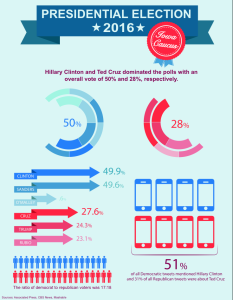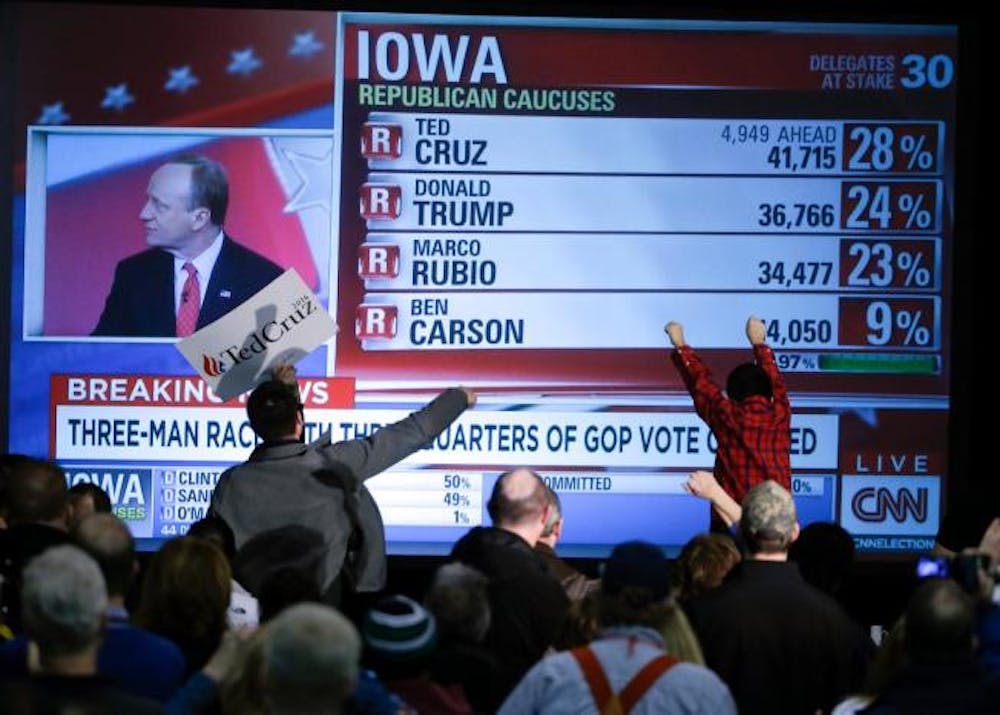By Jahnvi Upreti
Staff Writer
On Monday, Feb. 1, the nation held its breath in anticipation for the results of the Iowa caucuses. Ted Cruz won the state’s Republican nomination with 27.7 percent, a 3.3 percent lead on the runner-up, Donald Trump. The state’s Democratic nomination was much more nail-biting, with Hillary Clinton and Bernie Sanders battling it out at an almost even 50-50 percent for an hour, before it was decided that at 49.9 percent, Clinton was the winner, the New York Daily News reported.
Iowa is the first state in the country to vote for its Democratic and Republican presidential nominees, signaling the official beginning of the race toward the presidency. The caucuses serve to determine a party’s nomination for president, which eventually leads to officially electing a single political candidate to serve in the primaries. From church basements to high school gyms, voters from all of Iowa’s 1,774 precincts assembled in one of 800 designated public areas to discuss the candidates and place their votes as to who they believe should receive the primary nomination, according to the Daily News.
While Iowa is not the only state to hold caucuses, it carries great importance since it is the first state to weigh in on the nation’s opinions. These caucuses draw significant attention from the media and will affect how candidates perform in future primaries. Historically, Iowa has been the first state to hold caucuses since the Jimmy Carter era, the Daily News reported. Both Democratic and Republican parties have ruled for Iowa to be the first state. Though such a ruling is not legal, the parties punish any other state trying to host caucuses first by reducing the amount of delegates that state can send to the national convention.

The caucus is different for Democrats and Republicans. In the Republican caucuses, a few people voice their opinions on who should win before the other voters scribble their choices on pieces of paper, which is counted by hand. Such results are known as a straw poll, for the deciding votes do not have an impact on which delegates are sent to the convention. The information is simply released to the media. Following the voting, CNN reported that the caucuses decide which delegates to send to the county convention.
In the Democratic caucuses, voters physically move to various areas in the room to indicate which candidate they are in favor of. The groups are sized up and the candidates with the least amount of people in his or her designated area are taken out of the voting options. This activity is followed by negotiations, during which voters can try to defend their choices and convince others to support their nominees in the hopes of re-adding the candidate to the options. As stated by CNN, the number of votes each Democratic candidate gets decides the percentage of the precinct’s delegates who will represent that particular candidate at the convention. Unlike the Republicans, the Democratic procedure of running the caucuses does not allow a secret ballot. The Democratic voters made their preferences loud and clear.
By 11:30 p.m. on that evening, the results were in. Though winning the nominations from the Iowa caucuses give Cruz and Clinton an advantage, it certainly does not determine them as the official nominees for the primaries. Iowa is only the first caucus, after all. As Cary Covington, a political science professor at the University of Iowa, told the NY Daily News: “Iowa identifies the losers, it doesn’t choose the winner.”










